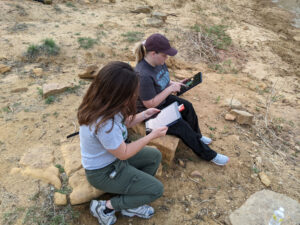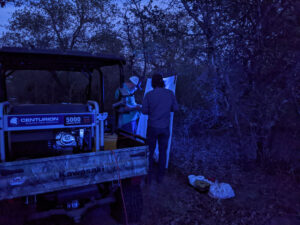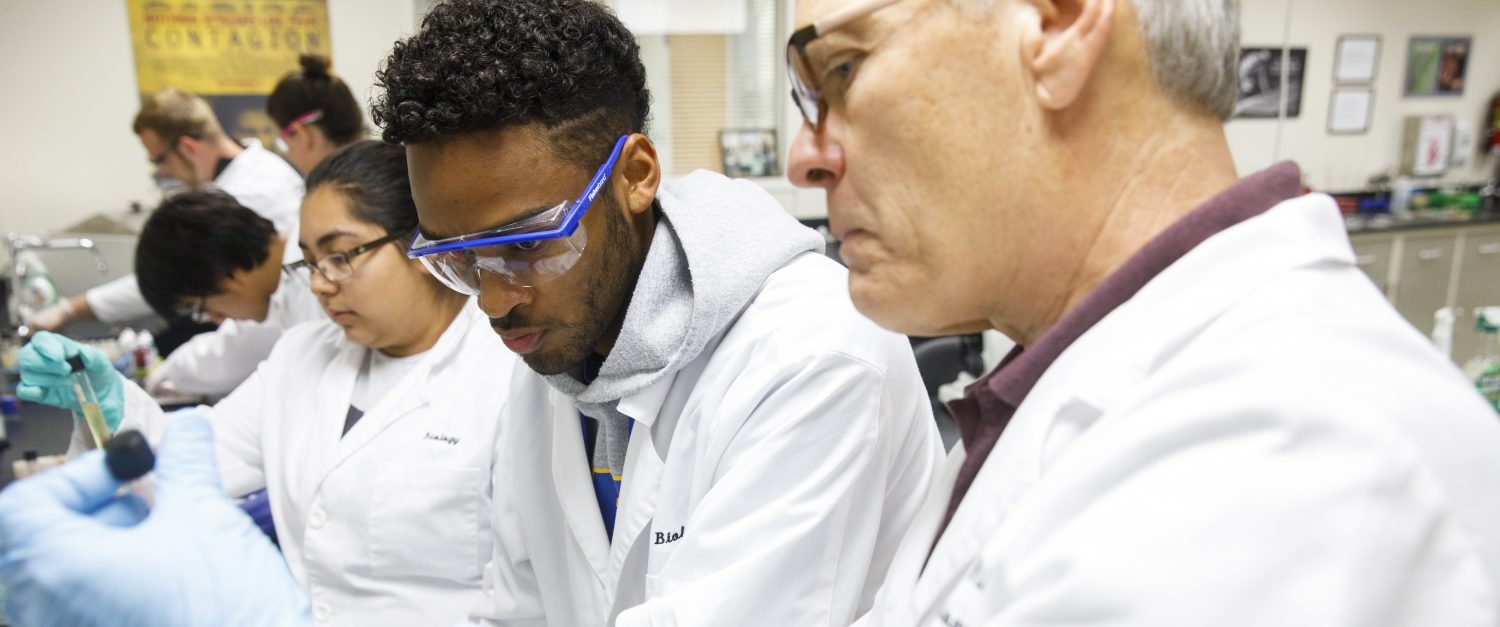McMurry and Cisco College students and faculty spent two days working at Firebase Libby (April 21-22, 2022). Students participating on research teams, or interested in belonging to a team in the future, at both institutions gathered to collect, tag, survey, and record data on the flora and fauna at McMurry’s research station: Firebase Libby. A total of 25 individuals participated in one or more of the Field Day activities.
Friday evening the students got to sample nocturnal animals. Dr. Boyle and his research team (Crab Boyle) set up UV-light traps for insects in the wood just west of the pond. Once the sun set, the insects flocked to the UV-lights. Daniel Ice is currently focusing on surveying the moths and butterflies (Lepidoptera) at Firebase Libby while Rebecca Blankenship is focused on the beetles (Coleoptera). UV-lights are great at attracting all kinds of insects so there are many more projects for interested students. At the pond, students got to sample the bat community using two methods: the “old school” bat nets for capturing bats and the “new school” bat detectors for recording the echolocation calls emitted by bats. While no bats flew into the nets, several were recorded using the bat detectors. While everyone else was focused on bats and insects, Luke Marshall and Bricelynn Sikes were stalking the edges of the pond in search of frogs. They were able to capture several cricket frogs (Acris blanchardi) and saw a couple of bullfrogs (Rana catesbeiana) just out of reach in the middle of the pond. Luke also caught some aquatic beetles for the invertebrate crew.
Saturday the students got to see how to sample aquatic invertebrates, grassland insects, and terrestrial vertebrates. Dr. Brad Blackwell showed how to use a dip net to sample aquatic invertebrates form the pond. He was able to catch several insect larval stages (damselfly larvae and dragonfly larvae) as well as a couple of worms and leeches. Dr. TJ Boyle and Daniel Ice demonstrated using sweep nets to sample grasshoppers, spiders, bugs, and butterflies while in the pasture. The Brant Scouts were checking the small mammal traps they had set the previous night. They caught six species including northern pygmy mouse (Baiomys taylori), Texas mouse (Peromyscus attwateri), white-footed mouse (Peromyscus leucopus), plains harvest mouse (Reithrodontomys montanus), fulvous harvest mouse (Reithrodontomys fulvescens), and hispid cotton rat (Sigmodon hispidus). All individuals were measured then tagged with an RFID chip so we could identify them when recaptured. While checking traps Dr. Brant caught a juvenile copperhead (Agkistrodon contortrix) and later Dr. Boyle found a 4-foot western diamondback rattlesnake (Crotalus atrox) while walking along the fence line. The rattlesnake was a large female that was probably 10 years old. Neither of these snakes was caught in our snake traps but both were measured, tagged, and then released. Sunday morning the Brant Scouts came back out to Firebase Libby to check/close the traps and caught a Texas spiny lizard (Sceloporus olivaceus), western coachwhip (Masticophis flagellum), and a yellow-bellied racer (Coluber constrictor).
Future field days attended by students at Cisco College and McMurry are planned for the coming academic year.
 |
Cisco students (Abigail Williams and Izabell Wiggins) used tablets equipped with ultrasonic bat detectors to listen for bat echolocation calls. The ultrasonic microphone listens for bat calls and the software gives a real-time visual readout on the tablet screen. The software also transforms bat calls into sounds that are audible to human ears, allowing researchers to actually listen to bat calls that are otherwise nonaudible. When a bat call is detected, the program attempts to identify the species of bat flying past the microphone. Species detected at Firebase Libby may include Lasiurus borealis (eastern red bat), Aeorestes cinereus (hoary bat), and Nycticeus humeralis (evening bat). |
 |
Daniel Ice and Dr. T. J. Boyle are setting up an insect light trap. The UV light attracted insects as they emerged from the leaf litter. The team successfully collected around 10 lepidopteran (moth) species and 10 coleopteran (beetle) species, but they saw another 20-30 species from various other orders. |
 |
Luke Marshall, member of Brant Scouts, handles a Western Coachwhip. Luke was very excited about all the snakes we caught. He kept saying, “this was a good weekend for herps!” And he was right. |

